

4 Privet Drive
A perfectly normal house, thank you very much
On 1 November, 1989, a mysterious wizard named Dumbledore appeared outside this quiet suburban abode. With his magical cigarette lighter, he extracted the light from all the streetlamps down the road. Moments later, he was joined by a transforming witch by the name of Professor McGonagall, and the half-giant Hagrid, who arrived on a flying motorbike clutching a baby boy. The mysterious trio placed the boy on the doorstep along with a letter, made out to Mr and Mrs Dursley of 4 Privet Drive, Little Whinging, Surrey. That boy would grow up to be none other than Harry Potter, the ‘Boy Who Lived’.
And it all happened right here. In 2000, this street in Martins Heron was transformed into the dreary neighbourhood of Privet Drive for Harry Potter and the Philosopher’s Stone (or Sorcerer’s Stone to you Americans), the first instalment in a film franchise that would go on to be the fifth highest-grossing of all time. The house at 12 Picket Post Close played the starring role of 4 Privet Drive, where Daniel Radcliffe lived as Harry Potter in the cupboard under the stairs. It was here that he received his invitation to Hogwarts from Hedwig, played by Ook the owl, by way of an avalanche of letters bursting out of the fireplace (all done with live practical effects).
For the disruption they’d endured, the residents of Picket Post Close were offered a small fee, but when they tried to up their rates for the second film, the producers decided it would be cheaper to build their own Privet Drive at Leavesden Studios. Today, a replica of 12 Picket Post Close can be seen as part of the Warner Bros. Studio Tour in Watford, and there’s even a Lego model of the home. Almost setting the record for the most expensive piece of Harry Potter memorabilia, the house sold in 2018 for the sum of £435,000. The new owners are accommodating of fans, but do be mindful to respect their privacy.
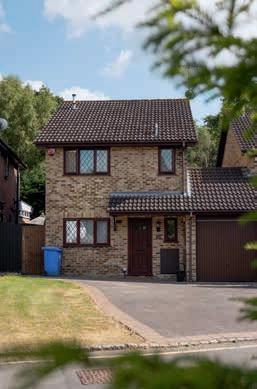

Address 12 Picket Post Close, Martins Heron, Bracknell RG12 9FG | Getting there Train to Martins Heron | Hours Private house, but can be viewed from the outside | Tip Fans of Terry Gilliam’s 1981 smash hit Time Bandits may also like to visit Haywood (RG12 7WG), which was the home of the film’s protagonist, Kevin.
Ascot Locomotive Society
The Racecourse line
You won’t find Royal Ascot Station on any railway maps, which is odd considering how busy it gets. Trains from all over the world converge on this spot, with trainspotters and young children alike struggling to contain their excitement at the sight of the Union Pacific Big Boy, or the Chesapeake & Ohio ALCO S-1. Then again, the station is not part of any railway network – its 820 yards of track form only a simple pleasure loop affording breathtaking views of Royal Ascot Golf Club and its centuries-old cherry trees, with a short whistle stop at Ascot United Football Club.
If you couldn’t tell already, this is not a real station; rather, it is the headquarters of Ascot Locomotive Society, a community-run model railway. First formed in 1988, the scale railway has changed its course several times over the years as the interests of its next door neighbour, Ascot Racecourse, have demanded. But this has not stopped its members being there, week-in, week-out. The labour force is dwindling as many of them approach old age, but their driving ethos – to keep young people fascinated and inspired by engineering – keeps them coming back.
One member you’re likely to bump into is former Chief Engineer Ian Rough. If you’re lucky, Ian might let you ride his pride and joy: a royal blue Class 7, the only one of its kind in England, which he designed in honour of his French penpal Dominique. He’ll also point you to some of his handiwork around the diorama – in particular, the enormous central turntable, which has become a popular way to end a journey.
If you start to feel a bit trainsick (who could blame you? Some of these locomotives get up to a top speed of 25mph), stop by the break room for a complimentary cup of tea. Just remember to leave a donation while you’re here, remembering the whole society is funded by the generosity of rail enthusiasts like you.
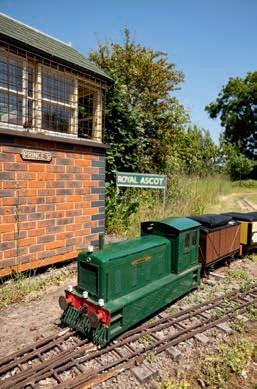

Address Winkfield Road, Ascot SL5 7LJ, ascotloco@hotmail.com | Getting there By car, follow Winkfield Road (A330) to the sign for ‘Locomotive Society’. Follow the road past the golf club. The Locomotive Society is on the left, with free parking in the field opposite. | Hours Society meets first Sunday of each month from 2pm; open days May – Oct first Sunday of the month (weather permitting), 2 – 5.30pm | Tip At the High Street end of Winkfield Road is the newly opened Hedone Ascot, a boutique food and wine store, with a bakery and a butcher’s that, between them, could give Harrods a run for its money.
Englemere Pond
The train will not be calling at Windsor or Ascot
As the town of Ascot becomes ever more desirable to wealthy expats from the big city, parcels of land that have been spared the developer’s clutches, and which have earned the title of protected nature reserve, are becoming hard to find. Thankfully, Englemere Pond has survived the creep of modernity, much to the satisfaction of both local residents and the countless species of birds, insects and reptiles who call this tranquil sanctum home.
Yet, if history had had its way, this precious pocket of paradise might not have lived to tell the tale. Once upon a time, this area was scheduled to become part of the Windsor to Ascot railway, a scheme that, after countless failed starts, ultimately came to nought.
The first proposal came in 1870, with the idea to build a fork at the southern end of the Windsor Railway Bridge (see ch. 106) to carry passengers through Clewer, Datchet and Cranbourne, and onwards to Ascot Racecourse with a terminus at Englemere Pond. An updated proposal in 1877 went one step further: instead of stopping at Englemere, the line would continue south to connect with the railway to Aldershot, forming a sprawling railway junction in the middle of the forest. Subsequent proposals saw the line extended to Fifield and Winkfield, and a final proposal in 1898 even proposed multiple snaking lines through Ascot with various stations dotted around the racecourse.
However, cracks in the plan appeared faster than renewed proposals could cover them up. Local opposition proved a powerful force, and the cost of purchasing some of the most expensive land in the country drove the total budget to over £10 million in today’s money. The Windsor & Ascot Railway Company officially formed in 1898, only to dissolve a year later when it was evident they would never be able to fund the project, and the scheme was finally put out of its misery on 9 December, 1911.
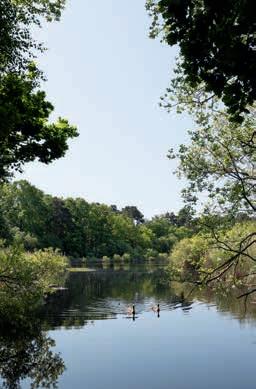
Address Swinley Road, Ascot SL5 8AB | Getting there Train to Ascot, then a 20-minute walk; the above postcode will take you to the free car park on Swinley Road (B3017) | Tip On the other side of Swinley Road is Whitmoor Bog. Every December, this forest plays host to Lapland UK, a fully-immersive Christmas experience – booking ahead essential (www.laplanduk.co.uk).
Jubilee River Walk
What a relief
The Thames giveth, the Thames taketh away. Life by the river affords many advantages, but it also brings the risk of flooding. The floods at Windsor featured regularly in The Illustrated London News throughout the 1800s – one artist’s impression from 1875 showed gondolas gliding down Windsor’s totally inundated streets.
In 1995, the town decided that enough was enough. It was time to try something drastic. The Thames Flood Alleviation Scheme was put in motion, with the plan to create a hydraulic channel taking excess water from the Thames at Maidenhead and returning it at Datchet. It would end up costing a cool £110 million and took seven years to complete, arriving just in time for Queen Elizabeth II’s Golden Jubilee, hence the name. The Jubilee River was an instant success, and Windsor has never seen flooding again since.
LOL, just kidding. By January 2003, the river had already failed in its design as Windsor saw its worst flood since 1947. Datchet, being on the receiving end of the torrent’s outlet, got hit twice as hard. Another £5 million was added to the bill to fund the repairs. It worked, and everyone lived happily ever after.
LOL, just kidding. Windsor flooded again in 2014, with Datchet once again taking the lion’s share. Sigh. Will it ever end? Who knows, but let’s not let it get us down. Let’s instead be glad the engineers were kind enough to install a fantastic footpath along the riverside.
And what a path! From Eton, you skirt around the outside of the playing fields, serenaded by an orchestra of cornflowers. From here, the space opens up to meadows of buttercups and daisies. Step up the Allotments Footbridge to see the lily pads floating near the weir, enjoy a spot of trainspotting on Chalvey Rail Bridge, and for God’s sake bring a bike – National Route 61 runs along the path and is the best way to see Windsor’s greatest hubris.
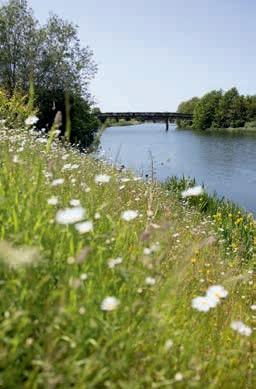
Address The path is 7.2 miles long and runs from Maidenhead to Eton and Slough | Getting there Free parking at Marsh Lane (Taplow SL6 0EB) and Jubilee River Riverside Centre, Slough Road (Slough SL1 2BP); pay & display parking at Boulter’s Lock Car Park, Lower Cookham Rd (Maidenhead SL6 8JN) | Tip Windsor’s worst floods occurred in 1774, 1894 and 1947. A flood level marker by Barnes Pool in Eton shows how high the torrents reached during those years.
moogBrew
Puts the ‘tap’ in Taplow
Sometime after the smoking ban came into effect, it became dreadfully trendy for pubs to have ‘secret beer gardens’. These invariably take the form of a converted hollow between the pub’s back wall and some adjacent building, with just enough room for a picnic bench. Gardens they ain’t, and given the fact they are usually advertised on the pub’s A-frames, one must also question whether they are truly secret. A real secret beer garden ought to be just that: a secret, the kind a man in a trench coat passes you in a manila envelope; and a garden, the kind with grass and flowers and bumblebees humming in the summer. Better still if the beer element is taken seriously too. To discover what a real secret beer garden looks like, make the short pilgrimage to moogBrew.
Husband and wife Id and Margi were pioneers of the British craft beer movement. After travelling the USA and the Low Countries for inspiration, they returned to England to start their own label in moogBrew. With cult comic artist Dave Anderson providing the branding, Id and Margi became big names in the beer-making scene. But, unlike many of their peers, the couple wanted to keep moogBrew a purely home-brewed affair. So, instead of expanding their enterprise and shipping worldwide, they decided to sell the product out of their own back garden.
With the blessing of their neighbours, Id and Margi have been pouring moogBrew from their summer house in Taplow since 2017. The beer itself is brewed just 20 yards away in their garage, and the taps change every season so that there is always some new concoction on offer. Beer lovers will find themselves in paradise, with oodles of whacky flavours to choose from, whether the aniseedy In Bruges or the grapefruit punch of Five-Citra. Come, relax, sample everything on the menu, and make Id and Margi’s garden your own – just, please, keep it a secret.
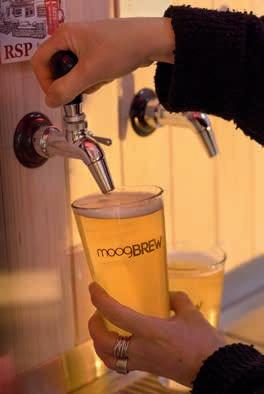

Address Meads End, Ye Meads, Taplow SL6 06H, +44 (0)7941 241954, www.moogbrew.co.uk | Getting there Train from Slough to Taplow (Elizabeth Line), then a 15-minute walk; bus 8 from Arthur Lane to Slough High Street, then bus 4 from Queensmere Car Park towards Maidenhead, alight at Marsh Lane, then a 10-minute walkTrain from Slough to Taplow (Elizabeth Line), then a 15-minute walk; bus 8 from Arthur Lane to Slough High Street, then bus 4 from Queensmere Car Park towards Maidenhead, alight at Marsh Lane, then a 10-minute walk | Hours These vary, so check the website or follow @moogBrew on Instagram and X for upcoming dates | Tip If you’ve arrived a bit early, stop by Taplow Lake to discover Lake House Café. Sit on the terrace and watch the water skiers and the kayakers – heck, why not get involved yourself? (Visit www.taplowlakeside.co.uk).
Savill Garden
The definitive English country garden
There is something embedded deep in the British DNA that draws us all, sooner or later, to gardening. The archetype of this national spirit was Sir Eric Savill who, from 1932 to 1951, reached the apex of landscape design with this, the jewel in the Great Park’s already heavily-encrusted crown.
Before Sir Eric arrived, the earth beneath this land was sandy, waterlogged and tree-riddled. It took a visionary of extraordinary calibre to ascertain that the moist earth and the natural canopies offered by the dense forest would make the perfect environment for a bountiful garden chock full of exotic plants.
The genesis of Sir Eric’s vision came to him as a child, when he would spend countless hours walking the Great Park – and it was at this time he became acutely aware of the lack of flowers across the landscape. After a stint on the frontlines of World War I, Sir Eric went into the family business of land surveying, but a fated job application brought him instead to the Great Park, where he immediately parlayed with King George V to create his dream garden. George agreed speculatively, but could not spare an ounce of budget, and so Sir Eric made do by trading the rabbits he had snared with local horticulturalists. When George and Queen Mary saw the first draft of what was then called The Bog Garden, they were suitably impressed, and even asked Sir Eric to expand the garden all the way up to the 34 acres it is today. When the garden was complete, George deemed it worthy of bearing Sir Eric’s name, and thus the Savill Garden was inaugurated.
Sir Eric’s aim was simply to plant as many flowers as possible, which he certainly achieved. There are too many species to name individually, but it is not any one individual breed that stands out, rather the full spectacle: a chromatic explosion in year-round bloom, a feast for the eyes as well as the nose.

Address Wick Lane, Englefield Green TW20 0UJ, +44 (0)1753 860222, www.windsorgreatpark.co.uk/the-savill-garden | Getting there By car, from the A30, follow Wick Road onto Wick Lane – parking available on-site | Hours Daily 9am – 6pm | Tip
Another visionary who took advantage of the Great Park’s waterlogged earth was Henry Flitcroft, who created the serene ornamental lake known as the Cow Pond. Follow the path north from the Savill Garden Visitor Centre to find it lurking in the hedgerows.
Sutherland Grange
Walking among famous company
Hidden away on the outskirts of Windsor is a meadow teeming with crane’s-bill and knapweed, a sanctum away from the fraught rush of the town outside. It has not one, not two, but three separate conservation areas, each overflowing with meadow-grasses, inviting bumblebees to feast on the nectar and pollen within. The slow-flowing Clewer Mill Stream runs around the north bank, where blue damselflies and water boatmen dance between the spindly branches of willow trees.
Today, Sutherland Grange is home to all of these species and many more, but they are not the most notable residents to have resided upon this Arcadian field. That honour is split between Mary Caroline Blair and Sir Dhunjibhoy Bomanji.
Let’s do Mary first. In 1861, she and her husband Arthur moved into the Victorian mansion adjacent to this meadow (which retains the name Sutherland Grange) to manage the house on behalf of the Duke of Sutherland. But Mary, an infamous social climber, wanted more than a job – she wanted the Duke. And so, after Arthur died in a verrry suspicious shooting accident, and then the Duke’s wife also passed away, she swooped. Barely four months later, she and the Duke were married, which caused such a stir that Mary was banished from high society and henceforth known as ‘The Scandalous Duchess’.
Sir Dhunjibhoy Bomanji, meanwhile, was a bombastic Bombay businessman. After amassing a fortune in the world of shipping, Sir Dhunjibhoy retired to England to concentrate on philanthropic pursuits. He had a manor house at Sutherland Grange (one of three that made up his Windsor estate), which has since been knocked down, and it was here that he hosted his esteemed charity colleagues. One of those men was Field Marshal Earl Haig, who would later establish the Royal British Legion. Sir Dhunjibhoy, in turn, commemorated Haig’s achievement with a statue erected at Edinburgh Castle.

Address 25 Burnetts Road, Windsor SL4 5TN | Getting there Bus 2 or W 1 to Ballard Green; free parking for up to three hours on site | Tip Further up Maidenhead Road you will spot the definitive clocktower of The Willows, another of Sir Dhunjibhoy’s mansion houses, and the only one still standing.
The Union Workhouse
From poor man’s prison to million-pound homes
‘Windsor is a delicious situation,’ wrote Jonathan Swift in 1711, ‘but the town is scoundrel.’ He wasn’t wrong. Windsor had become a town of two halves: on one side was the ‘delicious’ castle; on the other, the ‘scoundrel’ town, where rivers of filth flowed through the streets, vagrants festered in the rubbish heaps, and two out of every five children died before their fifteenth birthday.
The Poor Law Act of 1834 brought much-needed improvements to Windsor. Streetlamps came first, then a sewage system and gas works. Things were looking up, if you ignored the plight of the homeless – thankfully, another of Windsor’s, ahem, improvements was The Union, a workhouse intended to take these beggars off the streets.
Despite its sublime architecture, life at The Union was nothing but hard labour. The men spent their days digging trenches to build Windsor’s new roads, while the women worked non-stop in the kitchens. Still, the conditions were favourable to other workhouses of the era – the inmates were fed a good diet and received regular gifts, which may explain why drifters came to Windsor from as far afield as Ireland, Gibraltar and South Africa.
Workhouses were widely regarded as a blight on English society, and started to be shut down after World War II. In 1999, The Union was rebranded as Bear’s Rails Park, a luxurious housing estate where homes now regularly go for over £1 million – truly a symbol of Windsor’s transformation from scoundrel to delicious.
Still, one part of this private estate betrays its heritage as a quasiprison. Adjacent to the back garden is ‘The Spike’. Now used as a garage, this was once where men spent their days smashing stones into gravel, which was sifted out of the knee-high red hatches lining the walls. The iron bars across the tiny windows tell you all you need to know about the conditions they would have experienced inside…


Address Bear’s Rails Park, 17 Crimp Hill, Old Windsor SL4 2QY | Getting there
Bus 8 from York House to Toby Carvery, then a 15-minute walk; by car A308 South, right onto St Peter’s Road, then right onto Crimp Hill. Private road, but parking is available at nearby Crimp Hill Cemetery. | Tip Head back in to Old Windsor to find The Fox and Castle off Burfield Road (www.thefoxandcastleoldwindsor.com).
Windsor & Eton Brewery
Knights of the pint
Windsor’s history is drenched in beer. High-quality agricultural land, a robust water source and good transport links helped breweries like Jennings and the Windsor Brewery to get their hands on the necessary ingredients, and then to ship tens of thousands of barrels out of Windsor every year through the 1800s. The bubble burst in the 20th century, but the fundamentals remained, and it was only a matter of time before someone reignited the flame of Windsor’s brewing heritage.
Those firestarters came in the form of Will Calvert and brothers Jim and Bob Morrison. Approaching retirement, the trio decided in 2009 to start a microbrewery as a way to keep busy. With the help of Master Brewer Paddy Johnson, they crafted a bitter named Guardsman in honour of Windsor’s Coldstream Guards. The batch was a big hit, and set the team on a journey around the world in search of new ingredients, new techniques and new partners. A decade later and the founders still haven’t retired, but they have re-established Windsor as a brewing hot-spot. Their unpretentious unit on Duke Street now ships a staggering 1.5 million pints per year, with a catalogue that has grown to feature everything from a craft pilsner to a dark IPA. The best way to sample everything is with a trip to the brewery itself: the one-hour tour is a whirlwind of anecdotes, a slew of samples, and concludes in the taproom, which fills up on weekends with beer lovers from around the world.
The brewery is particularly proud of its Royal Warrant, which it earned for supplying its waste yeast to feed the cattle at the Royal Farm. Around the time of a Royal ceremony, the crew will inevitably put out a new concoction in honour of their neighbours up the road. You may even spot them pulling the kegs up to the Castle on a horse-drawn cart – another in a long line of nods to Windsor’s beery traditions.


Address Units 1 – 4 Vansittart Estate, Duke Street, Windsor SL4 1SE, +44 (0)1753 392495, www.webrew.co.uk | Getting there Train to Windsor & Eton Central, then a 10-minute walk; bus 7, 8, 71, 191, 702 or 703 to Windsor Boys’ School | Hours Taproom: Mon – Sat 10am – 10pm, Sun noon – 8pm; brewery tours every Sat at 12.30pm & 3pm | Tip Can’t make it to the taproom? You can still sample the range at The George on Eton High Street, the brewery’s flagship pub.
Windsor High Street
The final march of Elizabeth Stile
Most days around 11am, throngs of tourists jam themselves onto the pavements of Windsor High Street, clamouring for a view of the Coldstream Guards as they march from Victoria Barracks to the Castle. It’s usually a joyful, festival-like atmosphere. But it wasn’t always this way. Once, these crowds would have been jeering ‘shame, shame!’ and hurling rotten vegetables into the street. Just ask Elizabeth Stile who, in 1579, was dragged up this stretch of road by Richard Galis, landlord of The Harte & Garter. Elizabeth, along with her three friends, had been accused of witchcraft.
Richard Galis, son of the Mayor of Windsor, was a rich and powerful man with a screw loose. Local nurse Mother Dutten learned this the hard way when, while treating young Richard, he leaped up and shouted ‘Witch!’ That accusation spread fast, and it wasn’t long before a series of calamitous coincidences unfolded, raising suspicion against Mother Dutten, Elizabeth and their two friends. When Galis’ father died mysteriously, it was enough to set the whole town against the four women, and Galis fashioned himself the ringleader of a vigilante group to hunt them down. One by one, the forsaken women were marched down the High Street to the prison at Windsor Castle, before being sent to Abingdon for execution by hanging.
Today, Windsor High Street is a much more uplifting environment, a fast-flowing artery teeming with high-end shops, opulent hotels and swanky restaurants. As people make their way down this avenue, admiring the gorgeous Georgian terrace on one side and the Church of St John the Baptist on the other, it may be rather bizarre to imagine that they, along with the diners chowing down on steak, and the shoppers kitting themselves out in designer clobber, are ambling around the same space that was once the epicentre of Britain’s most notorious and scandalous witch hunt.
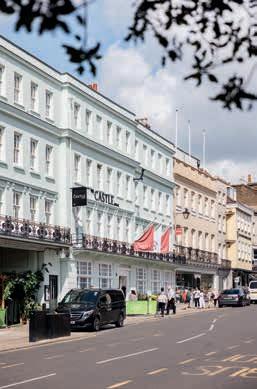

Address High Street, Windsor SL4 1LP | Getting there Train to either Windsor & Eton Central or Windsor & Eton Riverside, then a five-minute walk; served by most bus routes | Hours The Changing of the Guard takes place on odd days at 11am – visit www.changing-guard.com for upcoming events | Tip Richard Galis’ pub can still be found further down Thames Street, now a branch of The Ivy Collection.

Jonjo Maudsley is a writer, editor and historian from Bracknell, Berkshire. By day, he manages copywriting agency Scon, by night he runs the Bracknell Writers Group, and on lucky occasions he gets to pen travel stories for the likes of The Mirror and the Independent. His secret passion is the study of urban history, a subject he took all the way to Master’s level.

James Riley is an accomplished photographer and videographer originally from Berkshire. A graduate of Solent University’s renowned TV and Video Production course and founder of Ellipsis Creative, a highly sought-after creative agency in London, James’s portfolio has taken him worldwide, showcasing his skills in capturing captivating moments across diverse genres.
The information in this book was accurate at the time of publication, but it can change at any time. Please confirm the details for the places you’re planning to visit before you head out on your adventures.
